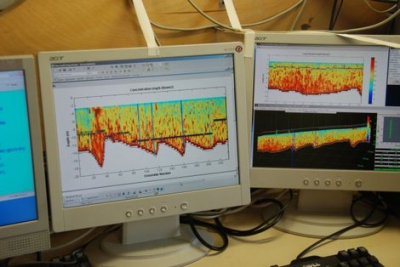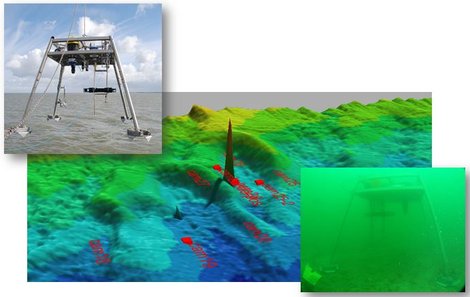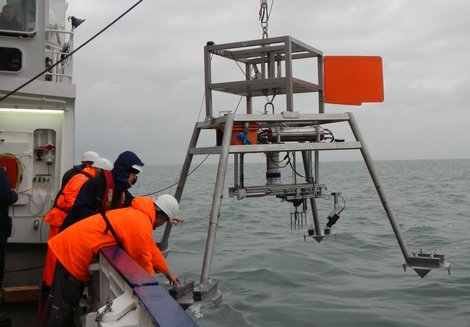Die Inhalte dieser Seite sind leider nicht auf Deutsch verfügbar.
Seitenpfad:
- Coastal Dynamics
- Projects
Projects
MARUM SD1
SD1 - Bridging scales: From small-scale morphological and sedimentological features to coast and shelf systems
Staff: Dr. Orencio Duran, Mohammad Amirshahi, Arnulf Möller, Benjamin Halstenberg
PIs: Christian Winter, Alexander Bartholomä, Tilo v. Dobeneck
PIs: Christian Winter, Alexander Bartholomä, Tilo v. Dobeneck
Currents, transported matter and sea bed morphology interact at a variety of temporal and spatial scales. In dependence of the sediment composition and transport characteristics and the hydrodynamic forcing, the movement of non-cohesive bed material results in different transport processes ranging from isolated motions of single particles, through the generation of ripples and dunes, to upper-stage plane beds, and even to the formation of antidunes in upper-regime supercritical flows. The transport of cohesive material, on the other hand, is a complex cycle of erosion, transport, settling, and deposition of single particles and aggregates. An exceptional condition is formed when large quantities of suspended matter settle in the benthic boundary layer to form highly concentrated nepheloid cohesive layers or even fluid mud at the bed.
This project addresses the quantification of the gouverning processes at the bed-fluid interfaces, the hydrodynamic drivers of bed instability, and significant time and length scales of pattern formation.
MARUM SD1 is funded for the period 2012-2017 as part of DFG-Research Center / Excellence Cluster „The Ocean in the Earth System“
Literature
Lefebvre A, Paarlberg A, Winter C (2016) Characterizing natural bedform morphology and its influence on the flow. Geo-Marine-Letters . doi. 10.1007/s00367-016-0455-5
Duran O, Claudin P, Andreotti B (2014). Direct numerical simulations of aeolian ripples. Proceedings of the National Academy of Sciences, 1413058111v1-201413058, doi:10.1073/pnas.1413058111.
Walters D, Moore LJ, Duran Vinent O, Fagherazzi S, Mariotti G (2014), Interactions between barrier islands and backbarrier marshes affect island system response to sea level rise: Insights from a coupled model, J. Geophys. Res. Earth Surf., 119, 2013–2031, doi:10.1002/2014JF003091.
Kwoll E, Venditti JG, Bradley R, Winter C (2016) Flow structure of high and low angle dunes. Journal of Geophysical Research – Earth Surface 10.1002/2015JF003637
This project addresses the quantification of the gouverning processes at the bed-fluid interfaces, the hydrodynamic drivers of bed instability, and significant time and length scales of pattern formation.
MARUM SD1 is funded for the period 2012-2017 as part of DFG-Research Center / Excellence Cluster „The Ocean in the Earth System“
Literature
Lefebvre A, Paarlberg A, Winter C (2016) Characterizing natural bedform morphology and its influence on the flow. Geo-Marine-Letters . doi. 10.1007/s00367-016-0455-5
Duran O, Claudin P, Andreotti B (2014). Direct numerical simulations of aeolian ripples. Proceedings of the National Academy of Sciences, 1413058111v1-201413058, doi:10.1073/pnas.1413058111.
Walters D, Moore LJ, Duran Vinent O, Fagherazzi S, Mariotti G (2014), Interactions between barrier islands and backbarrier marshes affect island system response to sea level rise: Insights from a coupled model, J. Geophys. Res. Earth Surf., 119, 2013–2031, doi:10.1002/2014JF003091.
Kwoll E, Venditti JG, Bradley R, Winter C (2016) Flow structure of high and low angle dunes. Journal of Geophysical Research – Earth Surface 10.1002/2015JF003637
NOAH TP2
NOAH - North Sea Observation and Assessment of Habitats, TP 2
Staff: Knut Krämer, Gabriel Herbst
PI: Christian Winter
PI: Christian Winter
Human pressures on sea floors of the North Sea are mounting and require a thorough inventory of status and functions of this important ecosystem component. The NOAH project has gathered multidisciplinary expertise to construct a comprehensive habitat atlas that assesses sea floor state and functions, and establishes baselines against which environmental changes can be determined.
This project addresses the gouverning processes at the bed-fluid interfaces, the hydrodynamic drivers of bed instability, and significant time and length scales of pattern formation at different representative sites in the German EEZ.
NOAH TP2 is funded 2013-2019 as part of the project NOAH - North Sea Observation and Assessment of Habitats in the BMBF Framework Programme Research for Sustainable Development (FONA).
Literature
Krämer K, Winter C. Predicted ripple dimensions in relation to the precision of in-situ measurements. Submitted to Ocean Science 18.5.2016 (doi:10.5194/os-2016-20)
Oehler T, Martinez R, Schückel U, Winter C, Kröncke I, Schlüter M (2015) Seasonal and spatial variations of benthic oxygen and nitrogen fluxes in the Helgoland Mud Area (southern North Sea). Continental Shelf Research 106, 118-129, doi:10.1016/j.csr.2015.06.009
This project addresses the gouverning processes at the bed-fluid interfaces, the hydrodynamic drivers of bed instability, and significant time and length scales of pattern formation at different representative sites in the German EEZ.
NOAH TP2 is funded 2013-2019 as part of the project NOAH - North Sea Observation and Assessment of Habitats in the BMBF Framework Programme Research for Sustainable Development (FONA).
Literature
Krämer K, Winter C. Predicted ripple dimensions in relation to the precision of in-situ measurements. Submitted to Ocean Science 18.5.2016 (doi:10.5194/os-2016-20)
Oehler T, Martinez R, Schückel U, Winter C, Kröncke I, Schlüter M (2015) Seasonal and spatial variations of benthic oxygen and nitrogen fluxes in the Helgoland Mud Area (southern North Sea). Continental Shelf Research 106, 118-129, doi:10.1016/j.csr.2015.06.009
MARUM CCP5
CCP5 - Organic-matter remineralization and nutrient turnover in permeable sandy sediments
Staff: Sören Ahmerkamp (MPI), Moritz Holtappels
PIs: Moritz Holtappels, Christian Winter
Associated scientists: A. Bartholomä, D. de Beer, V. Ernstsen, T. Goldhammer, M. Kuypers, F. Wenzhöfer
PIs: Moritz Holtappels, Christian Winter
Associated scientists: A. Bartholomä, D. de Beer, V. Ernstsen, T. Goldhammer, M. Kuypers, F. Wenzhöfer
Porewater flow in sandy sediments is a function of sediment permeability, bottom-water currents and seabed morphology. Porewater flow accelerates the mass transport into sandy sediment causing strongly increased rates of organic matter (OM) remineralization and denitrification.
Although ~60% of the highly productive shelf areas are covered by permeable sediments, OM remineralization and denitrification rates in these sediments are poorly constrained and are probably strongly underestimated. This SD-GB project will investigate interactions between physical sediment properties, hydro and morphodynamics and rates of benthic OM remineralization and denitrification in coastal areas.
The cross-cutting project CCP5 was funded for the period 2012-2015 as part of DFG-Research Center / Excellence Cluster „The Ocean in the Earth System“
Literature
Marchant HK, Holtappels M, Lavik G, Ahmerkamp S, Winter C, Kuypers MMM (2016), Coupled nitrification–denitrification leads to extensive N loss in subtidal permeable sediments. Limnol. Oceanogr.. doi:10.1002/lno.10271
Ahmerkamp S, Winter C, Janssen F , Kuypers MMM, Holtappels M (2015), The impact of bedform migration on benthic oxygen fluxes, J. Geophys. Res. Biogeosci., 120, doi:10.1002/2015JG003106.
Although ~60% of the highly productive shelf areas are covered by permeable sediments, OM remineralization and denitrification rates in these sediments are poorly constrained and are probably strongly underestimated. This SD-GB project will investigate interactions between physical sediment properties, hydro and morphodynamics and rates of benthic OM remineralization and denitrification in coastal areas.
The cross-cutting project CCP5 was funded for the period 2012-2015 as part of DFG-Research Center / Excellence Cluster „The Ocean in the Earth System“
Literature
Marchant HK, Holtappels M, Lavik G, Ahmerkamp S, Winter C, Kuypers MMM (2016), Coupled nitrification–denitrification leads to extensive N loss in subtidal permeable sediments. Limnol. Oceanogr.. doi:10.1002/lno.10271
Ahmerkamp S, Winter C, Janssen F , Kuypers MMM, Holtappels M (2015), The impact of bedform migration on benthic oxygen fluxes, J. Geophys. Res. Biogeosci., 120, doi:10.1002/2015JG003106.
BAW Susp III
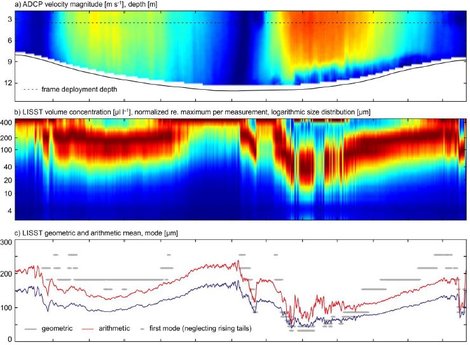
Suspended Matter Dynamics in German estuaries
Staff: Marius Becker
PI. Christian Winter
PI. Christian Winter
The R&D project is implemented, with the overarching goal to acquire and assess environmental parameters for an improved understanding of estuarine dynamics and validation of complex, process-based numerical modeling systems. The current third project phase is focusing on small scale transport processes, particle properties and vertical density stratification. The aim is to evaluate, test and improve methods to measure turbulence parameters and particle properties, and the stability and periodicity of vertical density gradients in tidal flows.
The project is funded for the period 2015-2018 by Bundesanstalt für Wasserbau, Hamburg.
The project is funded for the period 2015-2018 by Bundesanstalt für Wasserbau, Hamburg.
BAW MorphoWeser
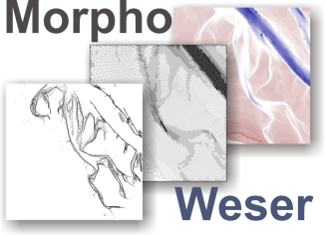
Morphodynamic processes in tidal estuaries of the German Bight
Staff: Gerald Herrling
PI. Christian Winter
PI. Christian Winter
The coperation project with BAW aims at a fundamental understanding of morphodynamic processes in the Outer Weser estuary in the German Bigh, North Sea. A high resolution numerical model has been set-up and is applied for a number of scenario simulations on the interaction of tides, waves and wind-driven currents, sediment transport patterns and the mobile bed in the tidal channels and tidal flats. Relevant morphodynamic drivers of different coastal elements are identified and evaluated.
The project is funded for the period 2015-2018 by Bundesanstalt für Wasserbau, Hamburg.
The project is funded for the period 2015-2018 by Bundesanstalt für Wasserbau, Hamburg.
INTERCOAST IC32
Modelling exchange between coastal elements
Staff: Markus Benninghoff
PIs: Christian Winter, Karin Bryan
PIs: Christian Winter, Karin Bryan
This project is based in the interdisciplinary cooperation The use of models in coastal research and law between lawyers and natural scientists. In the cooperation project we aim at:
• Improving the communication of methods of mathematical modelling and the formulation of causal connections in law.
• Developing recommendations both for the improvement of modelling census / verification and the legal criteria for model uses in decision-making contexts.
IC32 is funded 2016-2019 as part of DFG-International Research Training Group 'INTERCOAST - Integrated Coastal Zone and Shelf-Sea Research’
• Improving the communication of methods of mathematical modelling and the formulation of causal connections in law.
• Developing recommendations both for the improvement of modelling census / verification and the legal criteria for model uses in decision-making contexts.
IC32 is funded 2016-2019 as part of DFG-International Research Training Group 'INTERCOAST - Integrated Coastal Zone and Shelf-Sea Research’
WIMO

Scientific Monitoring Concepts for the German Bight: Intergrative Models A
Staff: Gerald Herrling, Chris Daly
PIs: Christian Winter, Dierk Hebbeln
PIs: Christian Winter, Dierk Hebbeln
WIMO was a partnership project between research institutions and state agencies including the national park administration of Lower Saxony's Wadden Sea. The project is aimed at providing methods of exploring seabed habitats, and detecting and analysing the dynamics of suspended solids, as well as forming a comprehensive representation and assessment of biodiversity, sensitivity to oil and eutrophication. For this, conventional sampling and measurements in situ are to be combined with modern remote sensing techniques complemented by integrative modelling. The subproject A addresses small scale morphodynamics of tidal inlets and the impact of extreme events on nearshore morphology.
The project was funded 2010-2015 by the Ministry for Environment and Climate Protection and Ministry for Science and Culture of Lower Saxony.
Literature:
Winter C, Herrling G, Bartholomä A, Capperucci R, Callies U, Heipke C, Schmidt A, Hillebrand H, Reimers C, Bremer P, Weiler R. 2014. Wissenschaftliche Konzepte für ein Monitoring des ökologischen Zustands des deutschen Küstenmeeres. Wasser und Abfall 07-08/2014; 21-26, DOI: 10.1365/s35152-014-0685-7
Herrling G, Winter C (2014) Morphological and sedimentological response of a mixed-energy barrier island tidal inlet to storm and fair-weather conditions, Earth Surf. Dyn., 2(1), 363–382, doi:10.5194/esurf-2-363-2014
Herrling G, Winter C (2015) Tidally- and wind-driven residual circulation at the multiple-inlet system East Frisian Wadden Sea. Continental Shelf Research, 106, 45–59., doi:10.1016/j.csr.2015.06.001
The project was funded 2010-2015 by the Ministry for Environment and Climate Protection and Ministry for Science and Culture of Lower Saxony.
Literature:
Winter C, Herrling G, Bartholomä A, Capperucci R, Callies U, Heipke C, Schmidt A, Hillebrand H, Reimers C, Bremer P, Weiler R. 2014. Wissenschaftliche Konzepte für ein Monitoring des ökologischen Zustands des deutschen Küstenmeeres. Wasser und Abfall 07-08/2014; 21-26, DOI: 10.1365/s35152-014-0685-7
Herrling G, Winter C (2014) Morphological and sedimentological response of a mixed-energy barrier island tidal inlet to storm and fair-weather conditions, Earth Surf. Dyn., 2(1), 363–382, doi:10.5194/esurf-2-363-2014
Herrling G, Winter C (2015) Tidally- and wind-driven residual circulation at the multiple-inlet system East Frisian Wadden Sea. Continental Shelf Research, 106, 45–59., doi:10.1016/j.csr.2015.06.001
INTERCOAST IC1b
Morphodynamic equilibria of coastal systems: Modelling the role of extreme event and average forcing
Staff: Brice Blossier
PIs: Christian Winter, Karin Bryan
PIs: Christian Winter, Karin Bryan
This project follows a process based approach to understand the different processes responsible for the development of coastlines and nearshore sandbars. Research questions comprise:
What external hydrodynamic conditions are driving the transition of a nearshore sandbar from state to state in an embayed beach environment?
Which nearshore hydrodynamic and morphodynamic processes are responsible for these transitions?
How does beach sedimentology reflect states and transitions?
IC1b was funded 2013-2015 as part of DFG-International Research Training Group 'INTERCOAST - Integrated Coastal Zone and Shelf-Sea Research’
What external hydrodynamic conditions are driving the transition of a nearshore sandbar from state to state in an embayed beach environment?
Which nearshore hydrodynamic and morphodynamic processes are responsible for these transitions?
How does beach sedimentology reflect states and transitions?
IC1b was funded 2013-2015 as part of DFG-International Research Training Group 'INTERCOAST - Integrated Coastal Zone and Shelf-Sea Research’
INTERCOAST IC1
Morphodynamic equilibria of coastal systems: Modelling the role of extreme event and average forcing
Staff: Chris Daly
PIs: Christian Winter, Karin Bryan
PIs: Christian Winter, Karin Bryan
This project follows a process based approach to the understanding of headland beach morphology, sedimentology and climatic and wave forcing to resulting static and dynamic equilibrium stages. The focus is set towards a numerical model approach based on schematic test cases and real world settings comprising the following objectives:
1. Compilation, evaluation, and analysis of available literature, remote sensing data, field data, and available large scale model results on headland beaches of the Coromandel Coast and Tauranga harbour tidal inlet in New Zealand.
2. Evaluation of large scale / long term dynamics based on available remote sensing data. Identification of dynamic or static equilibrium states of these beaches. Analysis of mean / dominant wave climate.
3. Measuring cross-shore morphological impact of storm events and average conditions.
4. Process based numerical modelling of beach morphodynamics
IC1 was funded 2009-2012 as part of DFG-International Research Training Group 'INTERCOAST - Integrated Coastal Zone and Shelf-Sea Research’
1. Compilation, evaluation, and analysis of available literature, remote sensing data, field data, and available large scale model results on headland beaches of the Coromandel Coast and Tauranga harbour tidal inlet in New Zealand.
2. Evaluation of large scale / long term dynamics based on available remote sensing data. Identification of dynamic or static equilibrium states of these beaches. Analysis of mean / dominant wave climate.
3. Measuring cross-shore morphological impact of storm events and average conditions.
4. Process based numerical modelling of beach morphodynamics
IC1 was funded 2009-2012 as part of DFG-International Research Training Group 'INTERCOAST - Integrated Coastal Zone and Shelf-Sea Research’
INTERCOAST IC3
Bedform Crest bifurcations in subaqeuous bedforms
Staff: Serena Fraccascia
PIs: Dierk Hebbeln, Christian Winter, Willem de Lange, Karin Bryan
PIs: Dierk Hebbeln, Christian Winter, Willem de Lange, Karin Bryan
Bedform crest bifurcations are recurrent, widespread characteristics of bedform fields in all environments; their existence has been reported in subaerial as well as in subaqueous conditions, from aeolian to riverine, to estuarine, to marine bedforms. The knowledge of the mechanisms behind bifurcations can lead to a better understanding of bedform pattern organization and bedform dynamics.
Some attempts of explaining the occurrence and development of crest bifurcations have been made in the last decades, but none of them has lead to a complete explanation of such a phenomenon. In fact, taking single process-response mechanisms into consideration for explaining crest bifurcations automatically excludes the generally accepted idea of a strict interaction and mutual influence between morphology, hydrodynamics and sediment dynamics. In addition, the extensive use of models and laboratory experiments, not always or properly supported by field data, do not allow to completely relate the results to natural features, as they only give an approximation which, as such, is inherently inexact.
A holistic and integrated approach to the subject may yield more fruitful results and unravel the interaction of environmental parameters and their role in the development and evolution of crest bifurcations. In addition, a study about crest bifurcations in tidal environments can promote either the validation or the rejection of some of the hypotheses advanced so far.
IC3 is funded as part of DFG-International Research Training Group 'INTERCOAST - Integrated Coastal Zone and Shelf-Sea Research’
Some attempts of explaining the occurrence and development of crest bifurcations have been made in the last decades, but none of them has lead to a complete explanation of such a phenomenon. In fact, taking single process-response mechanisms into consideration for explaining crest bifurcations automatically excludes the generally accepted idea of a strict interaction and mutual influence between morphology, hydrodynamics and sediment dynamics. In addition, the extensive use of models and laboratory experiments, not always or properly supported by field data, do not allow to completely relate the results to natural features, as they only give an approximation which, as such, is inherently inexact.
A holistic and integrated approach to the subject may yield more fruitful results and unravel the interaction of environmental parameters and their role in the development and evolution of crest bifurcations. In addition, a study about crest bifurcations in tidal environments can promote either the validation or the rejection of some of the hypotheses advanced so far.
IC3 is funded as part of DFG-International Research Training Group 'INTERCOAST - Integrated Coastal Zone and Shelf-Sea Research’
BAW Susp II
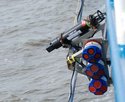
Suspended Matter Dynamics in German estuaries
Staff: Marius Becker
PI. Christian Winter
PI. Christian Winter
Dedicated field campaigns have been carried out in German coastal waters to allow for the analysis of several aspects of coastal hydro- and sediment dynamics. The research project aims towards integrating turbulence characteristics and their implications on aggregate size into an enhanced transfer function for the calculation of suspended matter concentration from ADCP backscatter and data.
The project is funded by Bundesanstalt für Wasserbau, Hamburg.
The project is funded by Bundesanstalt für Wasserbau, Hamburg.
COSYNA
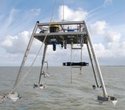
Near bed observation systems
Christian Winter et al.
Within the framework of HZG project COSYNA the working group "Near bed observation systems" has designed and set-up lander systems for the in-situ measurement of boundary layer processes. The landers are equipped with state-of-the-art sensor technology for the observation of hydrodynamics (waves, current profiles, turbulence), sediment transport (Grain size distribution, turbidity), oxygen fluxes, and morphodynamics.
The project is funded by HZG - Helmholtz Zentrum Geesthacht.
Within the framework of HZG project COSYNA the working group "Near bed observation systems" has designed and set-up lander systems for the in-situ measurement of boundary layer processes. The landers are equipped with state-of-the-art sensor technology for the observation of hydrodynamics (waves, current profiles, turbulence), sediment transport (Grain size distribution, turbidity), oxygen fluxes, and morphodynamics.
The project is funded by HZG - Helmholtz Zentrum Geesthacht.



